Chapter 1
What you need to know about Windows 10
What kind of people use Windows 10? The list is long and surprisingly diverse.
If you work in a modern organization, you probably spend the better part of every workday staring at a display—creating, communicating, researching, analyzing, sharing, and collaborating with co-workers. Yes, you can do some of those tasks on a mobile phone, but when you need to see the big picture, there’s nothing that works as well as a PC.
At home, you (and a few hundred million people much like you) use Windows 10 PCs for checking the news, making travel plans, shopping, and staying in touch over social media networks. You probably also play a few games and occasionally edit family photos and videos using that PC.
You might be a developer, in which case you spend a lot of time writing, testing, and debugging code. In the process, you use advanced features (like the Windows Subsystem for Linux) that mere mortals will never touch.
Or perhaps you actually manage PCs in business settings, in which case you have probably forgotten more about Windows deployment tools and techniques than most people will learn in a lifetime.
The one thing all of you have in common is that you’re probably not a newcomer to Microsoft Windows. Regardless of your productivity needs and your level of technical expertise, you’ve undoubtedly mastered little shortcuts that make you more productive in everyday computing activities.
For decades, one of the defining characteristics of Microsoft Windows—indeed, one of its greatest strengths—has been its respect for backward compatibility. That means most of those old tricks still work, and we don’t need to spend a lot of time dwelling on the familiar.
Instead, our goal in this book is to help you become more productive by helping you discover and master some of the big changes in Windows 10. For this, the fourth edition of Windows 10 Inside Out, we’ve updated every chapter with details covering the many changes in Windows 10 after more than five years and a dozen feature updates.
In this introductory chapter, we provide an overview of Windows 10 and point out some of the important improvements you might have missed.
Windows core features
As we began working on this edition in early 2020, Microsoft announced that its worldwide tally of active devices running Windows 10 had crossed the 1 billion mark. That milestone occurred just weeks after another historic date: the end of support for the long-lived, much-loved Windows 7.
If you’re among the substantial population that stuck with Windows 7 to the bitter end, avoiding Windows 8 and waiting a few years for Windows 10 to mature, you missed some interesting and deep-seated changes to core features in Windows. This section introduces some of those essential changes in the most important parts of the operating system.
The image-based setup process makes upgrading to Windows 10 faster and more reliable. It also powers the recovery tools, shown in Figure 1-1; the Reset This PC option allows you to reinstall Windows without having to search for installation media or product keys, with the option to keep your personal files or wipe the system clean. For more details, see Chapter 15, “Troubleshooting, backup, and recovery.”
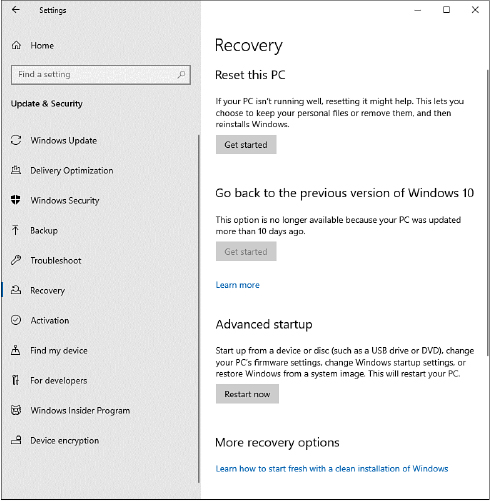
Figure 1-1 The Recovery options in Windows 10 allow you to reset a PC without requiring separate installation media or wiping out your personal files.
NTFS is still the default file system for Windows 10, but the primary file management tool has changed significantly from its Windows 7 predecessor. It’s no longer called Windows Explorer; beginning with Windows 8, the name officially changed to File Explorer. The addition of a Microsoft Office–style ribbon, shown in Figure 1-2, makes a number of formerly obscure operations more discoverable and dramatically improves search capabilities by adding a Search Tools tab when you click in the search box. Windows 10 adds a Quick Access region in the navigation pane. We cover File Explorer in exhaustive detail in Chapter 9, “Storage and file management.”

Figure 1-2 For anyone upgrading from Windows 7, File Explorer has a new name, an Office-style ribbon, and a OneDrive node in the navigation pane.
Some of the most important architectural changes in Windows 10 aren’t visible, but you can certainly see their impact on performance. Microsoft’s engineers have made steady and significant improvements in memory management, for example, which results in faster startups and more efficient management of running processes.
You can monitor system performance in Task Manager, another familiar Windows 7 utility that has received a major makeover in Windows 10. Press Ctrl+Shift+Esc to open Task Manager, and then click the Performance tab to see detailed information about the most important aspects of how the operating system is using available resources, as shown in Figure 1-3.
 For an in-depth look at the new Task Manager, see Chapter 12, “Performance and power management.”
For an in-depth look at the new Task Manager, see Chapter 12, “Performance and power management.”
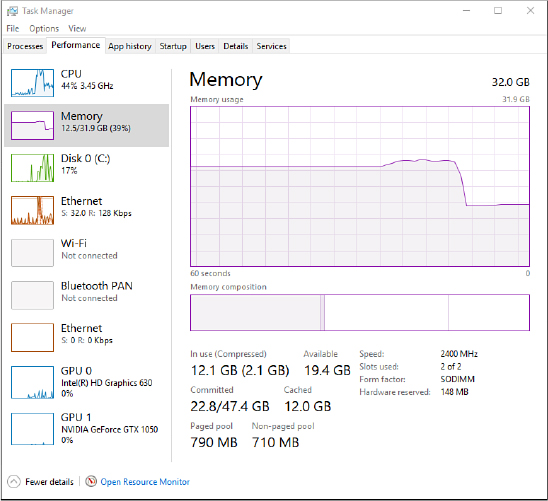
Figure 1-3 The Task Manager Performance tab in Windows 10 offers far more information and is more clearly organized than its Windows 7 predecessor.
Several other major architectural changes in Windows 10 are also on display in the previous figure. The networking stack in Windows 10 continues to improve with each feature update, for example. On modern devices that include multiple graphics processing units (GPUs), you can now assign a specific GPU on a per-app basis to improve performance. Other display-related changes include significant improvements when using multiple displays with different scaling factors.
Not every core feature has survived the relentless parade of semi-annual updates that make up Windows 10, however. HomeGroup, a signature networking feature that debuted in Windows 7 with the goal of making file and printer sharing easier, was officially removed from Windows 10 in version 1803. We have details of this change in Chapter 13, “Windows networking.”
Perhaps the most significant change of all in Windows 10 is the rapid transformation of a core feature that has been part of Windows for more than two decades. The venerable Internet Explorer is still part of Windows 10, but it is present strictly for backward compatibility. It was supplanted as the default browser by Microsoft Edge, which debuted with the original release of Windows 10 in 2015. But that legacy version of Microsoft Edge was itself replaced in 2020 by a completely new browser built on the open-source Chromium codebase. Confusingly, the new browser is also called Microsoft Edge. We explain the differences between the new Edge and the legacy Edge in Chapter 8, “Using the new Microsoft Edge.”
Because it shares a codebase with the popular Google Chrome, the new Edge should feel familiar to longtime Chrome users and is also unlikely to suffer from compatibility problems that plagued the legacy Edge. This is no Chrome clone, though. The new Microsoft Edge includes a strong privacy feature that prevents websites from tracking your movements online. You can see a portion of the Edge Settings page for this feature in Figure 1-4.
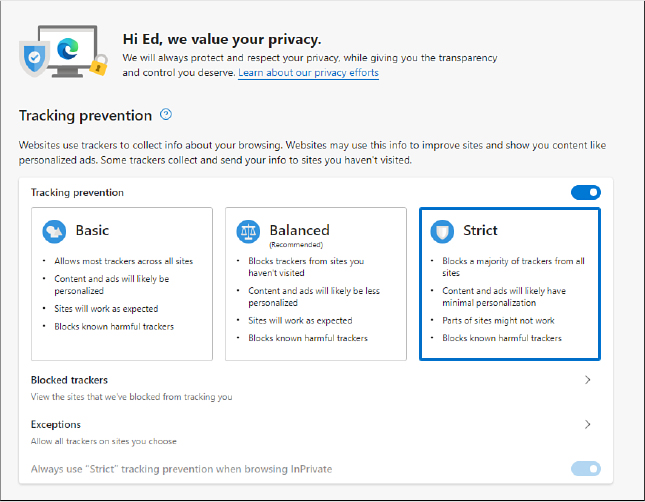
Figure 1-4 The new Microsoft Edge includes these tracking prevention controls. With Strict mode on, the feature functions as an effective ad blocker.
The new Edge browser continues to get new features, with new updates arriving roughly every six weeks. You can also expand the browser’s capability through the addition of extensions, which you acquire from the Microsoft Store or directly from Google’s Chrome Web Store.
The most compelling new feature of the new Edge is called Collections. As the example in Figure 1-5 shows, Collections are a way to assemble shortcuts to websites, snippets of text, images, and other web-based content and organize them in easy-to-share groups.

Figure 1-5 Microsoft Edge makes short work of web-based research tasks by allowing you to organize pages, text, images, and your own notes in Collections like this one.
Windows as a service
For decades, the cadence of Windows went something like this: Roughly every three years, a new version of Windows came out. New PCs included the latest Windows version; owners of existing PCs could choose to pay for an upgrade to the new Windows version or choose not to upgrade. The cycle began anew three years later, with the release of yet another new Windows version.
That’s all history now.
Before the initial release of Windows 10, Microsoft declared its intention to treat Windows as a service. In the first three years after that release, Windows 10 customers had a chance to see “Windows as a service” in action, with five feature updates that collectively would have qualified as one of the most feature-packed new Windows versions ever.

Any device running any edition of Windows 10 is eligible for feature updates. Instead of waiting two or three years to be included in a new Windows version or a service pack, new features are delivered automatically, through Windows Update. That’s a major change from previous Windows versions, which delivered only security and reliability updates through these Microsoft-managed channels.
 The sole exception to the above discussion of feature updates is the Long Term Servicing Channel, available for a specific version of Windows 10 Enterprise. You can read more about this unusual variant in “Windows 10 editions at a glance” in Appendix A, “Windows 10 editions and licensing options.”
The sole exception to the above discussion of feature updates is the Long Term Servicing Channel, available for a specific version of Windows 10 Enterprise. You can read more about this unusual variant in “Windows 10 editions at a glance” in Appendix A, “Windows 10 editions and licensing options.”
The new update process also allows Windows users to choose how soon they want to receive those updates.
Previously, Microsoft developed and tested new Windows features privately, occasionally offering the public an advance look in the form of preview versions before releasing them publicly. Beginning with Windows 10, those preview releases are built into the development cycle. As new features make their way into Windows, they’re delivered to different “flights,” starting with internal testers in Microsoft’s engineering group, and then working out to customers who have opted to join the Windows Insider Program and receive preview releases. Each new flight reaches a larger number of people, with fixes for bugs discovered in previous flights incorporated into later ones. Figure 1-6 shows, conceptually, how the process works.

Figure 1-6 For Windows 10, Microsoft delivers new features in “flights” that work their way through a series of test groups before being released to consumers and business customers.
Note
In Windows 10′s short existence, Microsoft has changed the terminology for its public Windows 10 release channels so many times, even we have trouble remembering the twists and turns. Previously, consumer and business releases were on separate timetables, called the Current Branch and Current Branch for Business, respectively. These were renamed to the Semi-Annual Channel (Targeted) and Semi-Annual Channel, and then the two channels were combined into a single Semi-Annual Channel. Along with the name change came a change in philosophy. Now, there′s one and only one release channel, with business customers expected to craft their own deployment schedules rather than waiting for a go-ahead from Microsoft.
After the preview phase concludes, the first public release of a feature update, goes to the Semi-Annual Channel. That release represents program code that has been tested through a long series of Windows Insider builds and corresponds to what have traditionally been General Availability releases of new Windows versions or service packs. Microsoft delivers the new version to PC manufacturers and also makes it available to the general public through Windows Update in a gradual release that can take months to complete. Each feature update appears as an optional update, with Microsoft offering the new release to devices that its algorithms identify as most likely to have a problem-free upgrade. Throughout the rollout, Windows engineers use diagnostic data and feedback from the first wave of installations to identify and resolve issues and roll up those fixes in monthly reliability updates.
Meanwhile, businesses are expected to create test groups within their organizations and allow them to validate a new feature update before deploying it more widely. IT managers and administrators on enterprise networks can choose a more cautious approach to feature updates by using Group Policy and management software to deploy new feature updates on a schedule of their choosing.
Microsoft’s developers receive unprecedented levels of feedback that shape the development effort in real time. That feedback comes from automated data collection (known formally as diagnostics and informally as telemetry) as well as from a Feedback Hub app, shown in Figure 1-7, which is installed with every Windows 10 release.

Figure 1-7 This Windows Feedback app allows anyone using Windows 10 to report bugs and offer suggestions directly to Microsoft.
 For more details on how Windows preview releases work, see Appendix B, “The Windows Insider Program.”
For more details on how Windows preview releases work, see Appendix B, “The Windows Insider Program.”
The app landscape
In this book, we pay proper respect to the legacy desktop apps that still account for much of the productivity work we do on PCs. That includes stalwarts like Microsoft Office and a practically endless list of third-party programs. In fact, a few desktop programs are still part of Windows 10, including Windows Media Player, Paint, Notepad, and WordPad. Most of those legacy apps are in maintenance mode at this point, with no new features; they remain a part of Windows 10 largely because third-party apps require them, and some Windows users have long-established workflows that depend on them.
Much more interesting are the apps that are designed and packaged to work on any device running Windows 10. Some of these apps are provisioned automatically with a new Windows 10 installation; others are downloaded from the Microsoft Store. In either case, because these apps can be updated automatically via the Store, they can incorporate new features and bug fixes without requiring a separate installation, as is usually the case with legacy desktop apps. With the help of a steadily evolving set of application programming interfaces (APIs), these apps can also sync settings and data between Windows 10 devices without having to reconfigure accounts or import data. When you set up a new Windows 10 device and install one of these so-called modern apps, you can literally pick up where you left off on the other device.
Windows 10 includes a lengthy list of productivity, entertainment, and news and information apps as part of a default installation. That list continues to grow, with several apps (Your Phone and People foremost among them) arriving years after the initial release of Windows 10. Other apps that are part of a default installation of Windows 10 have matured dramatically since their initial release, thanks in part to improvements in the underlying APIs.
Finally, some relatively recent additions to the Windows 10 platform expand the reach of the Store tremendously. First, those API changes allow developers of traditional desktop programs to deliver and update those programs through the Microsoft Store; the list of programs that have been repackaged in this fashion includes some megahits like Spotify Music and iTunes, as you can see in the Store listings in Figure 1-8.
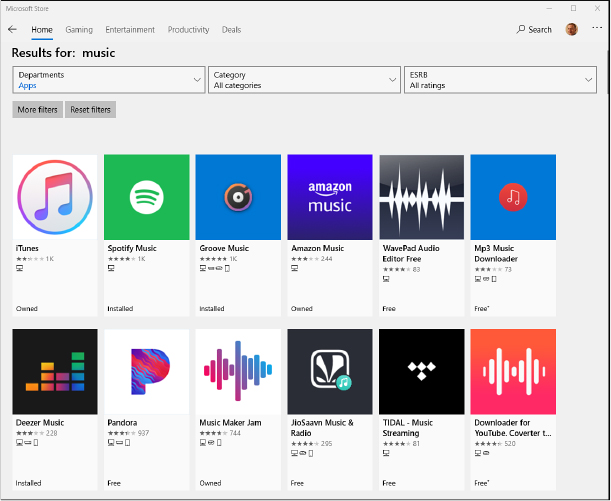
Figure 1-8 With a little effort, developers of traditional desktop programs, like iTunes and Spotify Music, can now deliver and update those apps through the Microsoft Store.
An additional set of APIs supports Progressive Web Apps, which are built on the same foundation and open standards as the web but allow features that aren’t available in a browser—working offline, for example, or accessing hardware directly. You’ll find more details about all of these app types in Chapter 6, “Installing and configuring apps.”
Chief among the productivity apps provisioned with Windows 10 are the three communication apps: Mail, Calendar, and People. These apps work with a broad swath of internet services, including Microsoft 365 and Outlook.com services, as well as Google’s Gmail and Apple’s iCloud. Figure 1-9 shows a month of appointments in the Calendar app.
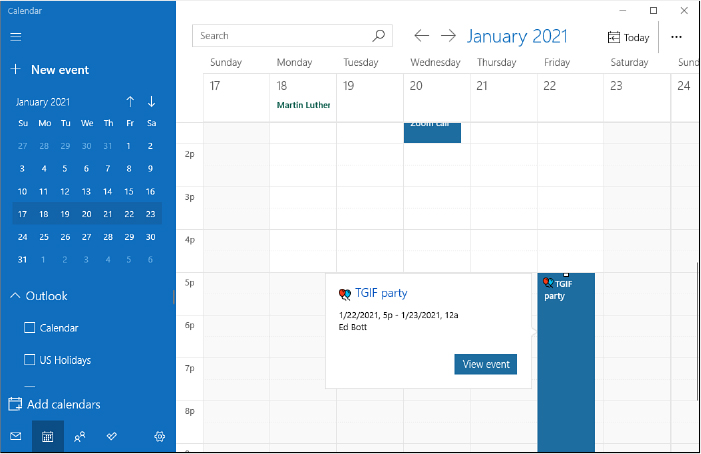
Figure 1-9 The Calendar app, shown here, is included with a default installation of Windows 10. Switch to the companion Mail or People apps using the icons in the lower-left corner.
If you looked at the Mail and Calendar apps during the first year or so after Windows 10’s debut and dismissed them as underpowered, it might be worth taking another look. For modern email and calendaring platforms such as Microsoft 365, Outlook.com, and Gmail, these apps offer a light, touch-friendly way to respond to incoming mail or check your calendar. You don’t have to replace your preferred mail/calendar client; you can use these apps as needed, in addition to a full desktop app like Outlook (included with some Microsoft 365 subscriptions) or a browser-based session. As a bonus, connecting accounts to the Windows 10 apps allows you to see events in the calendar flyout that appears when you click the date in the notification area.
Windows 10 also includes an assortment of entertainment apps and casual games (the Microsoft Solitaire Collection is included with every edition). The Photos app has become an especially interesting showcase for the Windows API, offering tools for editing digital pictures and then organizing them into albums or easy-to-share videos with music, as shown here.
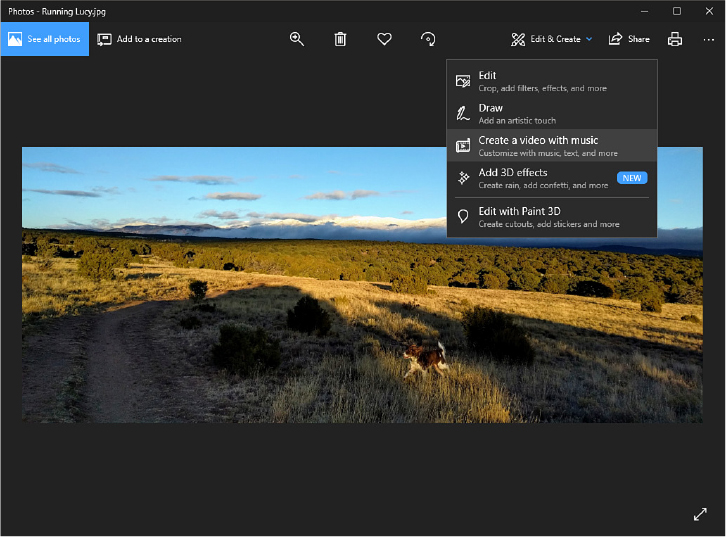
 For more information about apps and utilities included with Windows 10, see Chapter 7, “Using and managing built-in Windows apps.”
For more information about apps and utilities included with Windows 10, see Chapter 7, “Using and managing built-in Windows apps.”
These new apps for Windows 10 are delivered and updated through the Microsoft Store, just as their predecessors in Windows 8 were, but that’s where the resemblance ends. In Windows 10, Store apps can work in resizable windows alongside conventional Windows desktop applications.
On a tablet, for example, the editing capabilities in the new Photos app work best in full screen. On a large desktop display (or two), the full-screen view is overkill, and the app is perfectly usable in a window, as shown in Figure 1-10.
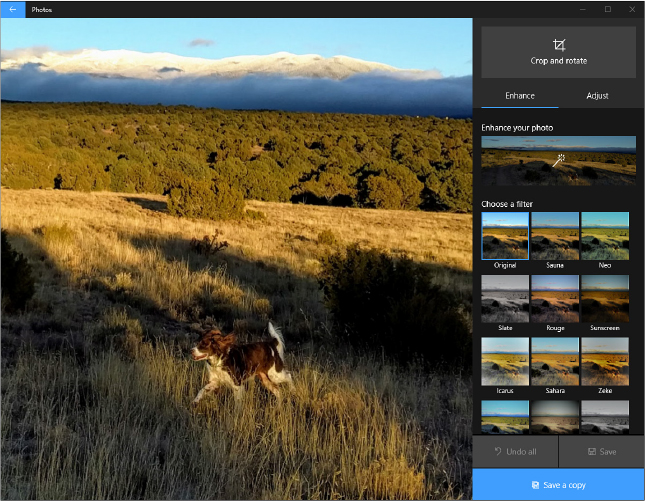
Figure 1-10 The editing controls in the Windows 10 Photos app are designed so that they work well in a resizable window on desktop PCs with a large display, a keyboard, and a mouse.
 For a more thorough look at how Store apps work, see Chapter 6.
For a more thorough look at how Store apps work, see Chapter 6.
Cloud connections
When you set up a new PC running Windows 10, you can create a local account and sign in, avoiding the cloud completely. If you do that, however, you miss some of the operating system’s most compelling features.
Throughout this book, we assume most of our readers are signing in with a Microsoft account (free to individuals) or an Azure Active Directory account associated with their organization. Doing so unlocks access to a variety of cloud services; signing in with the same account associated with a Microsoft 365 subscription (previously known as Office 365) provides a total of 1 TB of cloud storage for personal files. That’s a lot of online storage space.
The OneDrive synchronization client installed with Windows 10 supports connections to cloud storage from both the consumer version of OneDrive and its professional counterpart, OneDrive for Business, with synced files and folders available in File Explorer. And that sync client has been evolving methodically since the original release of Windows 10. It now includes a feature called Files On-Demand, which allows you to see all cloud files in File Explorer, even if they’re not synced to the local device. On consumer accounts, the default settings sync (and back up) key system folders to the cloud, as shown on the next page. That makes recovery easier after a hardware failure or even when a PC is compromised by a ransomware attack.

A second major Windows 10 feature that also depends on the cloud is Cortana. When you sign in with a work or school account, this “intelligent personal assistant” tracks appointments, sets reminders, and handles other work-related activities. Cortana recognizes your voice, if you choose to enable that option. Regardless of whether you choose to enable Cortana, the search box handles routine web searches and locates local files without the need to open a web browser or File Explorer.
 For more information about how OneDrive and Windows 10 work together, see Chapter 9. We cover Cortana’s capabilities in Chapter 10, “Cortana and Windows search.”
For more information about how OneDrive and Windows 10 work together, see Chapter 9. We cover Cortana’s capabilities in Chapter 10, “Cortana and Windows search.”
The user experience
How you react to Windows 10 is determined in no small part by how you feel about its predecessor.
With the launch of Windows 8 in October 2012, Microsoft removed the familiar touchstones of the Windows user experience—the Start button and Start menu—and replaced them with a radically redesigned Start screen created for use with touch-enabled devices. It also introduced a new class of touch-friendly apps, delivered through a new Windows Store. (In the Windows 10 era, the store’s branding changed. It’s now known as the Microsoft Store.)
The innovations in Windows 8 laid an essential foundation for tablets and other touch-oriented devices. But that new design also inspired some passionate and often blunt feedback from Windows users who weren’t pleased with the often-confusing changes to an operating system they had spent years mastering. Microsoft reacted to that feedback by reworking the user experience in Windows 10, bringing back the Start menu from Windows 7 and combining it with live tiles and other features that were introduced in Windows 8.
If you skipped Windows 8 and stuck with Windows 7, as we know many of our readers did, you missed several major iterations of the Windows user experience that some people found difficult to use on conventional PCs with a keyboard and mouse. By contrast, the Windows 10 user experience feels very much like a smooth evolution of Windows 7. After a dozen feature updates, the Windows 10 user experience has added considerable polish as well as some impressive all-new capabilities, such as the Timeline feature. (We’ll get to that in a minute.) The result should feel significantly more natural for anyone upgrading from Windows 7.
Our lightning tour of the Windows 10 user experience starts at the lock screen, which hints at a few of the security improvements we’ll talk about later. Note that instead of entering a password here, we can use a PIN assigned to this device, as shown in Figure 1-11. On some newer devices that support Windows Hello biometric authentication, you can skip that step completely and sign in automatically using facial recognition or a fingerprint.

Figure 1-11 The Windows 10 lock screen offers the option to sign in using a PIN (with the option of a hardware security device in this example) instead of a password.
After you successfully sign in, Windows 10 takes you to the Windows desktop. For anyone making the move from Windows 7, this environment should be familiar. The taskbar runs along the bottom, as expected, with a notification area on the right. In the lower-left corner is a stylized Windows logo. Clicking that button opens what Windows designers call the Start experience, an example of which is shown in Figure 1-12.

Figure 1-12 The Windows 10 Start experience combines the scrolling list of shortcuts from Windows 7 (left) with live tiles like those from the Windows 8 Start screen (right).
The height and width of the new Start menu are fully adjustable; there’s also a full-screen Tablet Mode, which works well on touchscreen devices without a physical keyboard.
Although the basic arrangement of Start in Windows 10 has remained consistent, subsequent updates have introduced some subtle but significant changes. In its current incarnation, the Start experience incorporates a scrolling All Apps list that is permanently available, while the power button and shortcuts to frequently used folders shrink to a slim column of icons on the left. (Click the button in the upper-left corner to reveal labels for those icons.) Tiles are resizable and can be organized into folders, which expand and collapse to reduce clutter.
Version 1803 introduced the most significant new addition to the Windows 10 experience: a feature called Timeline. Timeline expands the capability of Task View to include not just running apps but also “activities” you’ve allowed Windows 10 to track on your behalf: websites you’ve visited using Microsoft Edge, for example, and documents you’ve opened with apps that support the Timeline APIs. The list of supported apps includes every built-in Windows app (modern apps like Photos as well as legacy programs like Notepad) and all of the Microsoft Office desktop programs. Third-party programs that support the Timeline API, such as the members of the Adobe Creative Cloud family, are also included.
 For a more detailed discussion of Timeline, see “Reviewing, revisiting, resuming with Timeline” in Chapter 3, “Using Windows 10.”
For a more detailed discussion of Timeline, see “Reviewing, revisiting, resuming with Timeline” in Chapter 3, “Using Windows 10.”
The visual design of Windows 10 uses flat icons and a monochromatic color scheme in the notification area and in the Settings app, as shown in Figure 1-13.
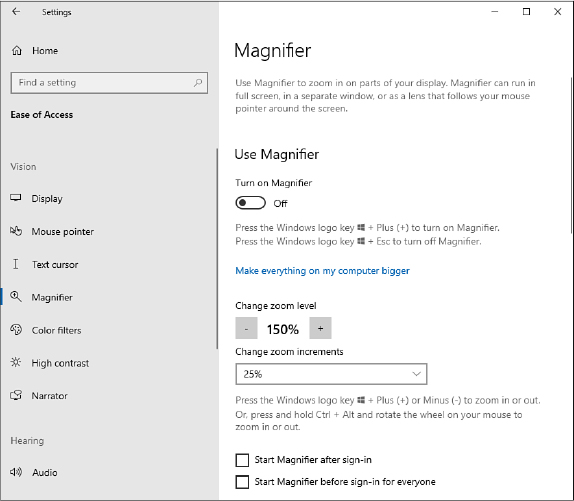
Figure 1-13 The Windows 10 Settings app adds more options with every feature update; its overall design and typography are characteristic of the operating system.
The Settings app debuted in 2012 with Windows 8, and its evolution accelerated under Windows 10. Over nearly a decade, Microsoft’s designers and engineers have been steadily moving user controls from the old Control Panel to their new home. That work has taken major steps forward with each feature update, as new categories appear (settings for a linked smartphone, for example, now appear in their own Phone category) and major groups of options migrate permanently to Settings, like the Networking options shown in the next graphic. The iconography and typography have become more sophisticated over time, and other recent changes include the incorporation of shadows and transparency, part of a major set of visual enhancements Microsoft calls Fluent Design.

The Windows 10 user experience isn’t just an evolution of features you already knew, however; you’ll also find plenty of new capabilities to explore.
The search box to the right of the Start button, for example, returns answers directly from the web, without the need to open a browser. These results can be as simple as a link to a Wikipedia article that matches the search terms, but the expanded search results pane can also include weather forecasts, sports scores, biographies, currency conversions, a full-featured calculator, and even a built-in translator.
Another major addition, new in Windows 10 and significantly refined in recent feature updates, is Action Center. This pane appears on the right side when you swipe in from the right on a touchscreen or click the Notifications icon, which appears to the right of the system clock. A badge over that icon shows how many new notifications are available. In addition, you can now tweak notification settings on an app-by-app basis, with more intelligent grouping options. The top of the pane contains notifications from apps (new messages, weather alerts, alarms, reminders), while the bottom contains handy buttons for performing common tasks. Figure 1-14 shows what Action Center looks like in version 1803. More recent versions have not changed this basic organization.
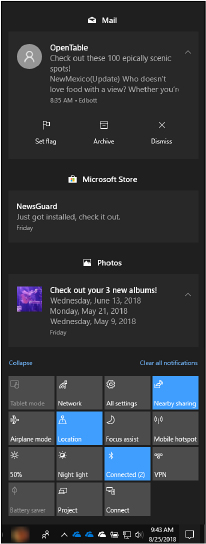
Figure 1-14 The buttons that appear beneath notifications in Action Center allow quick access to system settings.
PC hardware
They don’t make PCs like they used to.
We don’t mean that as a figure of speech, but rather as a statement of fact that helps to explain why Windows 10 exists.
Every year, Microsoft’s hardware partners sell hundreds of millions of PCs running the latest version of Windows. Many of those PCs still follow traditional form factors: towers designed to fit under a desk, all-in-one PCs that pack the electronics behind a desktop display, and clamshell-shaped laptops with full keyboards and touchpads.
But the fastest-growing group—and by far the most interesting—have diverged from those familiar designs. The defining characteristic of these next-generation Windows devices is a touchscreen. On touchscreen-equipped laptops, you can choose to perform a task by tapping the screen or by using the keyboard and touchpad. In the case of a tablet running Windows 10, the touchscreen offers the only way to navigate between and within apps.
Note
The core code that makes up Windows 10 runs on a broad assortment of hardware, including the Xbox One game console, HoloLens mixed-reality smart glasses, and the Surface Hub, a large, touch-enabled smart display designed for corporate conference rooms. In this book, we focus on devices designed to perform the functions associated with traditional PCs.
Then there’s the most intriguing category of all: so-called hybrid devices, equipped with a touchscreen and a keyboard that can be detached or folded out of the way. The touch-enabled displays in Lenovo’s perfectly named Yoga series, for example, can rotate 360 degrees, turning a laptop into a tablet with the keyboard behind the display.
Microsoft’s popular Surface devices also help define the category. The Surface Pro and Surface Go, for example, support Type Covers that magnetically attach to add a keyboard and a precision touchpad. The Surface Book series looks and acts like a traditional laptop until you push the Detach button and remove the screen from the base. When you remove the keyboard from the display and use a Surface Pen, a Surface device becomes a tablet you can use to sketch or take notes.
Windows 10 is the engine that powers all those next-generation devices as well as the large population of traditional PC designs still in use.
On a touchscreen, you swipe and tap to interact with objects on the screen and use an on-screen keyboard to enter and edit text. For devices with detachable keyboards, Windows 10 includes features designed to ease the transition between the traditional PC way of working and the new Tablet Mode. In the case of PCs that aren’t touch-enabled, Windows 10 offers the familiar keyboard-and-mouse experience, with no compromises.
 We offer details on how to be productive with the Windows 10 user experience on traditional PCs and touchscreen-equipped devices in Chapter 3. Our coverage of customization options is in Chapter 4, “Personalizing Windows 10.”
We offer details on how to be productive with the Windows 10 user experience on traditional PCs and touchscreen-equipped devices in Chapter 3. Our coverage of customization options is in Chapter 4, “Personalizing Windows 10.”
Security and privacy
Windows 10 has a broad set of security features, many of them built into the core of the operating system and thus essentially invisible. For example, modern hardware designed for Windows 10 starts up from a Unified Extensible Firmware Interface (UEFI) rather than an old-fashioned BIOS. That hardware design, in turn, enables a Windows 10 security feature called Secure Boot, which protects your PC from an insidious form of malware called rootkits.
Other core security features of the operating system are enabled by default, including the Microsoft Defender Antivirus software included with every installation of Windows 10. (If you or your organization have installed an alternative security software solution, Microsoft Defender Antivirus steps aside gracefully.) You can monitor and configure the full set of user-facing security features from a consolidated dashboard (see Figure 1-15) called Windows Security. (In versions 1803 and earlier, this app was called Windows Defender Security Center.)
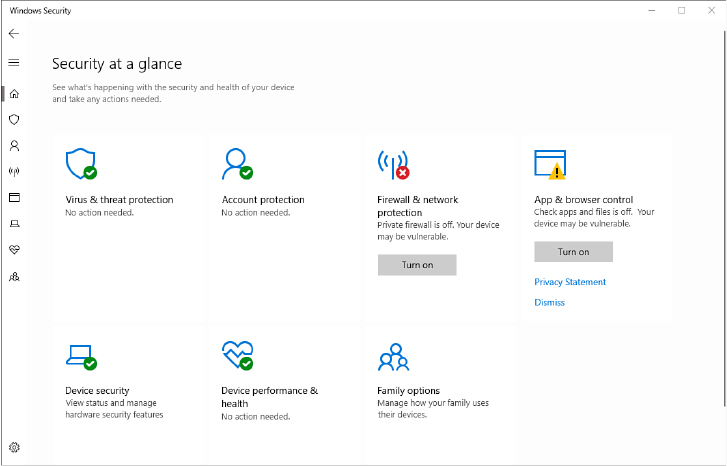
Figure 1-15 The green check marks, red X, and yellow triangle denote the status of each feature. Clicking any option here opens a configuration dialog box for that feature.
Each of the categories listed here can be configured with minimal technical knowledge, making this the primary window into security on Windows 10 PCs running in homes and small offices where a full-time IT department isn’t available.
More advanced security options include multi-factor authentication options for PCs as well as BitLocker Disk Encryption, which is available on PCs running Windows 10 Pro or Enterprise editions. (Modern PCs running Windows 10 Home provide device encryption for the system drive, but only if the user signs in with a Microsoft account.)
Privacy options in Windows 10 are extensive, with the most confusing choices revolving around the diagnostic data (sometimes referred to as telemetry) that Microsoft collects as part of its product improvement efforts. Recent feature updates include a new tool called the Diagnostic Data Viewer, which allows you to inspect the diagnostic data being sent to Microsoft under your current privacy settings. We discuss this topic in detail in Chapter 18, “Windows security and privacy.”
